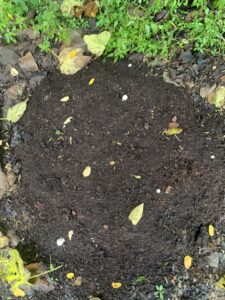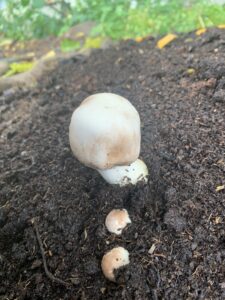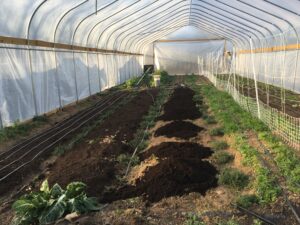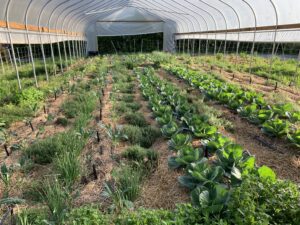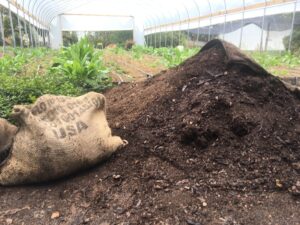Final report for FS21-331
Project Information
Our solution to managing specialty mushroom waste is to create value added structure. Piles of half-decomposed sawdust blocks have enormous potential to become compost for secondary enterprises like on-farm soil fertility applications for plant production, substrate for mushroom production in the agaricus (button mushroom) genus and wholesale retail compost.
Consumer demand for specialty mushrooms like oysters and shiitake continues to grow in the US with 10% increase year over year. With growing cultural interest and high price point, these wood-loving organisms can provide our communities a way to digest agricultural and agroforestry waste in the form of soybean hulls and sawdust to produce high protein rich food. Furthermore, this mushroom growing technique is the primary way that nature decomposes lignin (wood fibre) for smaller microorganisms to digest further into compost. Compost and healthy soils are continually lost in conventional agricultural communities and urban development. Providing specialty mushroom farmers cost analysis on proper disposal and handling of this half-decomposed waste stream could be paramount to not only providing these farms with extra revenue but also for providing farming communities with rich compost, a much needed input to keep up with the fertility needs and also increase the biodiversity needs of our ecosystems. The compost at HENOSIS was analyzed by Cornell’s Waste Management and given excellent results with regard to micro and macro nutrients as well as our in-field trials using this compost in our vegetable and herb production plots which anecdotally resulted in robust yields. We believe this revenue could easily pay for the additional labor cost, even if done by hand. Furthermore this mushroom compost can then again be used for diversified farms' vegetable/herb production to lower COGS or sold retail or wholesale to local nurseries.
Compost Analysis Cornell Waste Managment
Mushroom compost has it’s own economic value not only for plant production but as a means to grow secondary decomposer mushrooms in the agaricus family like button mushrooms and portobello. While these mushrooms are widely produced and consumed in the US and the barrier to entrance may be high for small farms to compete in this industry, looking at lesser known varieties like the agaricus sup. (Almond Portobello) as a secondary crop for specialty mushroom growers could provide another revenue stream for these farmers while minimizing cost of goods sold (COGS). This mushroom has been studied in the past by SARE by Sharondale Farm (FS08-227), though with outdoor production techniques rather than the indoor production techniques widely used in common button mushroom farms. Having assessed button mushroom production guidelines by Dr. David Meigs Beyer at PENN St. University and the quality of our in-house produced compost, it seems feasible that we would be able to use these resources and producion practices to produce a higher-valued mushroom, such as the almond portobello as pictured below from HENOSIS' own outdoor preliminary trial.
This rare mushroom can provide a secoundary revenue with an estimated value of $25-$50/pound if integrated in production processes if proper attention is given to this waste managment process.
HENOSIS will be using thermophilic composting guidelines provided by Pennstate University in the disposal process of our mushroom sawdust blocks, measuring temperature and moisture rates, to ensure uniformity for reliable production of agaricus mushrooms.
We will establish sawdust block to compost ratios monitoring compost mass reduction for agaricus substrate use to understand the amount of compost that can be produced for upcycling.
Continuing into Phase 2 production guidelines, we will then pasturize finished compost in plastic bags used in specialty mushroom production with the use of low-tech steam chambers that are adequate in our regular specialty mushroom production process and inoculate blocks with verifiable grain spawn from Field and Forest, a mushroom spawn company with success in growing Almond Portobello mushrooms
Spawn expansion will take place for 90 days, as we monitor growth parameters. After blocks are fully colonized we will add them into our fruiting chambers adding casing layers similar to button mushroom production.
If mushrooms should produce, we will harvest and measure production by weight. After two harvest we will dispose of blocks in spent compost piles. The whole process will take place over 1/month for 10 months to account for seasonal weather and market trends
Throughout this process labor cost will be monitored to provide a baseline of cost in producing a secondary mushroom.
Cooperators
- - Producer
Research
Check out our research results on our YouTube channel
Creating Compost - It takes 300, 5# bags of mushroom substrate (blocks) to create a cubic yard of finished compost. On a small scale, the pile should be created in a bin system to maintain the thermal mass required to keep temps at 185F. Pallets work well to make walls and hold the organic matter in form. It takes approximately 1 hour to break 300 blocks out of their plastic bags, broken up with a spade and, piled up to 4'x4' mass. Time to turn .75 hours (45 min), approximately 3-4 hours per batch of blocks. It may take 30 - 90 days for blocks to be composted. This timeframe can vary depending on factors such as the initial moisture content, temperature management, and frequency of turning the compost pile to maintain aerobic conditions. Regular monitoring and turning every three days will help keep the process efficient and within this range.
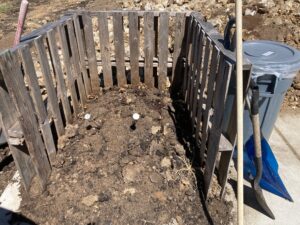
Managing/Monitoring Compost- We turned the compost every three days to ensure that the piles would be uniform, stay aerobic, and maintain their heat.
Testing Compost - We followed the rules from Cornell's compost lab to ensure that we were getting them the best samples to get nutrient data. (ADD Cornell/PSU Lab Sample Doc)
Bagging Compost - DO NOT ADD COMPOST INTO MECHANICAL MIXER/BAGGER
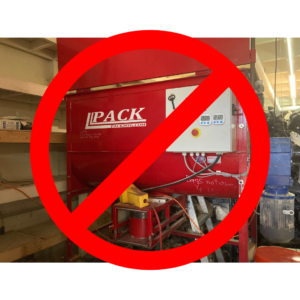
While most farms have moved to mechanical bagging systems with the use of a soil mixer, we found that this was not conducive to this compost. The compost usually falling between 55 - 62% moisture content coagulated and turned into a cement-like substance that would not go down the shoot into the filter bags. Doing it by hand in a water trough or wheel barrow while not as efficient only takes 35 min to fill 50 bags
Pasteurizing Compost - Unlike specialty mushroom pasteurization using sawdust, it is important not to reach temps above 180 in your steam barrels and letting the compost substrate blocks rest for 24 hours to allow time for microorganism populate in the warmer conditions. Much in the same way that conventional button mushroom substrate is pasteurized, these microorganisms act as a food source for the mushroom mycelium. One and two barrel pasteurization systems work well but closely monitoring the temps is imperative. How long did it take our system to get the core to 180
Inoculation with Grain Spawn - Once the bags are below 100F they should be inoculated with AS spawn. We tried both sawdust and grain spawn for this research. Finding grain spawn can be a little more difficult and special ordering may be required. Sawdust spawn tends to be easier to obtain from companies like Field and Forest and works just as well. The inoculation rate is approximately 2 ounces/5 pound block and should be conducted in front of a HEPA filter sealed and stored in an incubation system. Time .75 hours
Incubation For this tropic strain, it is best to store the inoculated compost blocks in warmer conditions not normal to temperate climate mushrooms (blue oysters, lions mane, and shiitake) but slightly warms in the 76F - 80F degree temps. Creating another incubation room within a room works well with a heater and an inkbird digital temp regulator to maintain temps . It takes approximately 90 days for the compost blocks to fully colonize to a completely white myceliated block. ADD PICS of incubation room/colonized block.
Top Dress - After full colonization, it is best to case the mushroom blocks with sterilized coconut coir. It takes approximately 1.25 hours to case 50 blocks
Harvest (BE)
Overall mushroom production per batch of blocks varied widely, as conditions across the production process varied due to infrastructure issues, spawn quality,and incubation time. Like producing any mushroom variety, it is imperative to use sawdust or grain spawn that is less than a month old. For AS production, we produced more mushrooms with blocks that incubated for 90 days. While mushrooms were produced in bags with 45 days of incubation, it was half of the output but on average we produced .25 - .5 pounds/block.
We successfully demonstrated that Almond Portobello mushrooms can be cultivated using spent SMS (spent mushroom substrate) from primary wood-loving mushroom production, including oyster, shiitake, and lion’s mane mushrooms. The resulting compost was comparable in quality to that used in conventional button mushroom farms.
From disposal and compost management to block production, harvest, and final disposal, the labor hours were approximately 7.5 hours per 50-block batch. At a livable wage of $20 per hour, the total labor cost per batch is $150, or $3 per block. With an average yield of 0.25 pounds (4 ounces) per block, the production cost translates to about $12 per pound of mushrooms.
To achieve profitability, we recommend selling Almond Portobello mushrooms at $24 per pound until yields increase and biological efficiency improves. This price accounts for any additional expenses related to sales and distribution. Additionally, it could be profitable to produce extracts (tinctures) while maintaining the same production efficiency.
These prices do not reflect the potential added value from selling the remaining compost after mushroom cultivation, which could sell for $45-$80 per cubic yard, similar to conventional button mushroom farms. Due to the current production volume, further analysis of market demand is necessary to determine clear consumer demand levels.
Assumptions:
- Yield per Block: 0.25 pounds of mushrooms.
- Labor Cost per 50 Blocks: $150 (7.5 hours at $20/hour).
- Selling Price per Pound of Mushrooms: $24.
- Revenue per Block from Mushrooms: 0.25 pounds * $24 = $6.
- Revenue per Cubic Yard of Compost: $45-$80 after mushrooms have been cultivated.
- Production Cost per Block (Labor): $3.
Revenue from Mushrooms
For every batch of 50 blocks:
- Total Mushroom Yield: 50 blocks * 0.25 pounds = 12.5 pounds.
- Total Revenue from Mushrooms: 12.5 pounds * $24 = $300.
Cost Analysis for Mushrooms
-
Labor Cost per 50 Blocks: $150.
-
Total Cost per Block (excluding compost revenue): $3 per block, totaling $150 for the batch.
-
Gross Profit from Mushrooms per Batch:
- Total Revenue - Labor Cost = $300 - $150 = $150.
Revenue from Compost
After cultivating mushrooms, compost can be sold at $45-$80 per cubic yard. Since 300 blocks yield 1 cubic yard, each 50-block batch produces about 1/6 of a cubic yard.
- Revenue per 50 Blocks from Compost:
- At $45 per cubic yard: 16×45=7.50\frac{1}{6} \times 45 = 7.5061×45=7.50
- At $80 per cubic yard: 16×80=13.33\frac{1}{6} \times 80 = 13.3361×80=13.33
Total Potential Revenue and Profit per 50-Block Batch
-
Total Revenue per Batch (Mushrooms + Compost):
- Low Estimate: $300 (mushrooms) + $7.50 (compost) = $307.50.
- High Estimate: $300 (mushrooms) + $13.33 (compost) = $313.33.
-
Total Profit per Batch:
- Low Estimate: $150 (from mushrooms) + $7.50 (compost) = $157.50.
- High Estimate: $150 (from mushrooms) + $13.33 (compost) = $163.33.
Annualized Potential Revenue and Profit
Assuming two 50-block batches per week (a conservative estimate) over 52 weeks:
-
Annual Revenue:
- Low Estimate: $307.50 * 52 weeks * 2 batches = $31,980.
- High Estimate: $313.33 * 52 weeks * 2 batches = $32,186.32.
-
Annual Profit:
- Low Estimate: $157.50 * 52 weeks * 2 batches = $16,380.
- High Estimate: $163.33 * 52 weeks * 2 batches = $16,993.32.
Summary
- Potential Revenue per Batch: $307.50 - $313.33.
- Potential Profit per Batch: $157.50 - $163.33.
- Annual Revenue Estimate: $31,980 - $32,186.32.
- Annual Profit Estimate: $16,380 - $16,993.32.
Based on our analysis, the cultivation of Almond Portobello mushrooms from spent mushroom substrate (SMS) is a promising venture with considerable potential for both revenue and profitability. Each 50-block batch generates approximately $307.50 to $313.33 in revenue, including compost sales. This translates to a profit range of $157.50 to $163.33 per batch when labor costs are considered.
On an annual basis, with two 50-block batches per week, the projected revenue is between $31,980 and $32,186, with an estimated annual profit ranging from $16,380 to $16,993. These figures highlight a viable opportunity to integrate mushroom and compost production, maximizing value from mushroom cultivation waste and establishing a secondary revenue stream through compost sales.
To enhance profitability, further improvements in yield and biological efficiency are recommended. Additionally, introducing mushroom extracts (tinctures) could expand product offerings and increase profitability. This model not only leverages sustainable waste management practices but also creates a scalable framework for other specialty mushroom farms seeking to add value through diversified production.
To improve margins we believe that further research and execution should go into the following:
- Adapt button mushroom industry equipment for the following:
- Managing compost
- Bagging compost substrate - this may be resolved in monitoring compost moisture content to adapt to mixers.
- Applying casing such as peat moss or coco coir and inoculating casing to increase colonization.
- Develop strains of Agaricus sub that produce more mushrooms/block
- Optimize compost substrate for higher yields
Educational & Outreach Activities
Participation summary:
Outreach being limited by covid 19, we plan to concentrate our efforts online. The results of our research and or how-to instructional video will be distributed on our website, local farming websites such as Middle TN Farmers, Montgomery County Extension Agencies' "Slow Your Roll" and to well-trafficed facebook groups like Mushroom Growers which has over 147,000 members world-wide.
Learning Outcomes
Comprehensive Utilization of Spent Mushroom Substrate:
Demonstrated how spent mushroom substrate (SMS) can be effectively composted and repurposed, creating a sustainable and valuable input for secondary mushroom production.
Mastery of Compost Management Techniques:
Gained knowledge of best practices for managing compost, including maintaining optimal temperature, moisture content, and aeration to ensure nutrient-rich and high-quality compost.
Analysis of Production Efficiency:
Developed an understanding of the labor requirements, time allocation, and cost implications for each stage of the production process, from composting to harvesting.
Identification of Scalability Strategies:
Explored scalable solutions such as equipment upgrades, workflow optimization, and strategic labor allocation to support larger-scale production while maintaining quality and efficiency.
Economic Viability Assessment:
Analyzed the cost per block and projected revenue, including potential supplemental income from compost sales, to understand profitability and the return on investment for the production process.
Techniques for Yield Improvement:
Identified methods for enhancing biological efficiency and increasing yields, ensuring a more productive and profitable mushroom cultivation process.
Quality Control in Pasteurization and Inoculation:
Highlighted the importance of maintaining proper sterilization and inoculation techniques to minimize contamination risks and support robust mycelial growth.
Understanding Optimal Growth Conditions:
Determined the ideal environmental parameters, such as temperature and humidity, for both the incubation and fruiting stages to achieve consistent and high-quality mushroom yields.
Exploration of Value-Added Product Opportunities:
Investigated potential revenue streams from secondary products, such as mushroom extracts and post-harvest compost sales, and evaluated their contribution to overall profitability.
Market and Demand Insight:
Understood the significance of assessing market demand, setting competitive pricing, and developing effective strategies for marketing and selling mushrooms and compost.
Project Outcomes
Assessment of Project Impact on Agricultural Sustainability
Economic Benefits
The project demonstrates clear economic advantages for farmers by turning what was once waste—spent mushroom substrate (SMS)—into valuable products. By repurposing SMS into compost and using it to grow high-value Almond Portobello mushrooms, farmers can generate additional revenue streams. Each 50-block batch yields profit margins between $157.50 and $163.33, demonstrating that the process can be economically sustainable and profitable. Moreover, selling post-harvest compost at $45-$80 per cubic yard provides further financial opportunities. The dual revenue potential from mushroom and compost sales offers farmers a way to diversify income sources, reduce production costs by reusing byproducts, and enhance profitability.
Environmental Benefits
Environmentally, the project contributes to sustainability by promoting waste reduction and resource efficiency. The process diverts spent mushroom substrate from landfills and transforms it into nutrient-rich compost, reducing the ecological impact associated with disposal. The composting process enriches the soil with essential micro and macro nutrients, as evidenced by the nutrient analysis from Cornell, which supports healthier and more fertile soils. This practice helps farmers manage agricultural and agroforestry waste while promoting a circular economy where inputs are reused effectively. The result is improved soil health, which enhances crop yields and supports biodiversity, contributing to a more resilient agricultural ecosystem.
Social Benefits
Socially, the project empowers farmers by providing them with knowledge and tools to maximize the value of their resources. Implementing sustainable waste management practices can improve farm profitability and stability, which supports local economies. By integrating this process, farmers can produce high-protein, nutrient-rich mushrooms that contribute to food security and offer a viable alternative to conventional farming. Additionally, the potential for job creation and the transfer of skills related to compost management, mushroom cultivation, and sustainable farming practices enhances community development. The project also promotes awareness and adoption of regenerative agricultural practices, encouraging a shift towards more sustainable farming models.
Overall Contribution to Future Sustainability
This project lays the groundwork for a scalable model that other specialty mushroom farmers can replicate, creating a ripple effect that benefits the broader agricultural community. By fostering an approach that emphasizes resource reuse, economic gain, and ecological stewardship, the project ensures that farms can thrive while reducing their environmental footprint. The integration of composting, secondary mushroom production, and value-added products not only diversifies farm offerings but also strengthens the sustainability of agricultural operations, positioning them to adapt and succeed in a changing agricultural landscape.
Recommendations for Future Study
-
Enhanced Yield Optimization:
- Further research should be conducted to refine and improve the biological efficiency of growing secondary mushrooms such as Agaricus subrufescens. This includes studying the optimal inoculation techniques and substrate formulations to maximize yield.
-
Economic Analysis at Larger Scale:
- An in-depth analysis of scaling this process on a commercial level would be beneficial to assess labor-saving technologies, mechanization potential, and cost efficiency in larger operations.
-
Nutrient Cycling and Soil Health Studies:
- Future studies could focus on the long-term impacts of using mushroom-derived compost on soil health and crop productivity. Assessing how regular use affects soil biodiversity and nutrient retention would provide valuable insights for sustainable farming.
-
Consumer Market Research:
- Understanding consumer demand for lesser-known specialty mushrooms such as Almond Portobello in different regions could help farmers target their markets more effectively and guide pricing strategies.
-
Sustainable Packaging Solutions:
- Investigation into biodegradable or eco-friendly packaging for compost and mushroom products could further align with sustainability goals and reduce the environmental footprint of farm operations.
Comments for SARE
I would like to express my gratitude to SARE for supporting projects that align with regenerative and sustainable farming practices. This project has underscored the potential for turning agricultural waste into valuable resources, benefiting not only farmers but also the broader agricultural community. Continued support and funding for studies that innovate in waste management, resource recycling, and sustainable product development are essential for fostering resilient farming systems.
Future initiatives that encourage knowledge-sharing and community education about sustainable practices will further empower farmers and promote widespread adoption of regenerative techniques. Thank you for considering these insights and recommendations.
